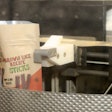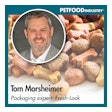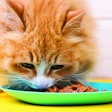This month we bring you some petfood packaging examples that caught our eye on a visit to the Expozoo exhibition held outside Paris. The tone of the show was set by an Affinity Petcare display based around a massive mock-up of a bag, highlighting the upgrades in pack information that have been launched recently by the European petfood giant.
It explained that Affinity's underlying aim has been to inform the purchaser more clearly about the contents of the particular dog food pack and to use standardized icons to pick out the benefits to the animal from the product's consumption. Additionally, now there is a better indication of the size of the dog for which the food is intended.
We were interested, however, to see how much emphasis was also being placed on the construction of the pack. The display pointed out the use of bags with a metalized interior, for example, besides the fact that a zip closure has been added to promote extra freshness.
Paper bags fight back
Pack design and construction were topics of a conversation I had with some people involved in types of packaging for dry petfood. They assured me that, from a European perspective, the paper bag industry has been reacting to the increasing competition from the plastic bag industry in the petfood market.
The market itself is becoming more and more sophisticated and demanding, they added. The response from the paper sector therefore has needed to be thought out carefully to meet the modern requirements.
From their own viewpoint, today's version of paper bag packaging is seen as the answer to the needs of this growing market. Their contention is that it offers high performance in terms of printability, shelf stability and grease barrier characteristics, with the natural property of the paper to be environmentally friendly at a time, they comment, when sustainable development is becoming a priority.
"The paper bag industry has been working for years to help the petfood product to differentiate itself on the shelves and to be closer to consumer needs," declared Glauca Vesperini, who is marketing manager for flexible packaging at Ahlstrom. "The latest innovations in this field include paper bags with sliding zips."
As an example, said Vesperini, take the case of a new concept of paper bag with a sliding zip that has been patented by the French company Roland Emballages. This company, a specialist in flexible packaging (films, paper and aluminum) since 1903, has demonstrated that a zip-type slide fixed on the top of the bag creates real added value. Bags fitted with its Sliderol are easy for the petfood user to open and close, and also the contents can be tipped out easily into the pet's dish. In addition, it is possible to add handles to the bags to make them easy to carry.
Vesperini reports that various European private label operators, including some well-known retail chains, have now decided to take up this packaging option for their own-brand products. Their choice is specifically a slide close pack produced using Ahlstrom's Gervalux paper to give a total grease barrier and high-quality printing surface.
"Many petfood producers have been opting recently to use the same concept for their dry foods," says Glauca. "It is in line with their policy of sustainable development policy and at the same time it offers cost-effective packaging. Look around and you will find other European developers are entering the market with innovative ideas oriented to the latest needs. The consumer will be able to choose from a wide choice of paper-based packaging solutions."
Awards for Italian purchases
Points mean prizes, in a pack-related promotion started in May by Agras Delic in Italy. The wrapper on every pack includes a tab that the customer is invited to cut off and collect. Tabs convert to points. When enough points have been collected, they can be exchanged for a gift chosen from a catalog of prizes.
The promotion is for the Italian market alone, but the company has other ideas to promote itself internationally. These relate in particular to a superpremium range of moist complete meals for dogs and cats that bears the brand name of Schesir.
Agras Delic can trace its own origins back almost two decades. Schesir is new by comparison. It was introduced in Italy less than five years ago and only now is being rolled out to other European countries such as Spain, France and the Netherlands.
Italian sales last year reached 5 million tons, the company reports. That represented an increase of 20% compared with 2003. A similar rate of growth has been recorded so far in 2005.
The premium and superpremium slice of the overall market in Italy evidently has kept growing despite a national downturn for petfood products in general. Equally clear is that the segment is drawing in more and more competitors, making promotion and positioning important to a product's success. The philosophy followed by Agras Delic for Schesir concentrates on the pet shop rather than the supermarket. The company has a separate product line, Adoc, for selling through the grocery chains.
Health benefits
Every exhibition in Europe these days seems to illustrate the increasing number of Italian companies trading internationally in petfoods. One making its first foray into exporting at Expozoo was Sanypet, from the northern Italian city of Padua. For most visitors, the eye-catching aspect to its packs had to be the line across the top of every bag proclaiming a guarantee of health.
This appeared on the feeding program sold as Forza 10 and described as completely hypoallergenic for dogs and cats. In fact, formulation against food-related disorders has been taken to the extreme of eliminating all macro-ingredients with the exception of fish, vegetable oil and rice. Even the fish is specifically ocean-caught, not farmed.
There is definitely a marketing message in having products that are devoid of meat, the company insisted. Relatively few pets have an actual allergy to the protein consumed. More often, ailments are due to an intolerance of the traces of chemical substances that can occur in the meat of food animals from certain production systems. Veterinary nutrition to address this possibility is well accepted, especially when bolstered by health-sustaining elements such as the presence of omega-3 and omega-6 fatty acids.
However, the message has not been limited to veterinary clinics alone. The company's international hopes rest on repeating the penetration achieved nationally in Italy by also selling through non-veterinary outlets, including garden centers and pet shops.


















